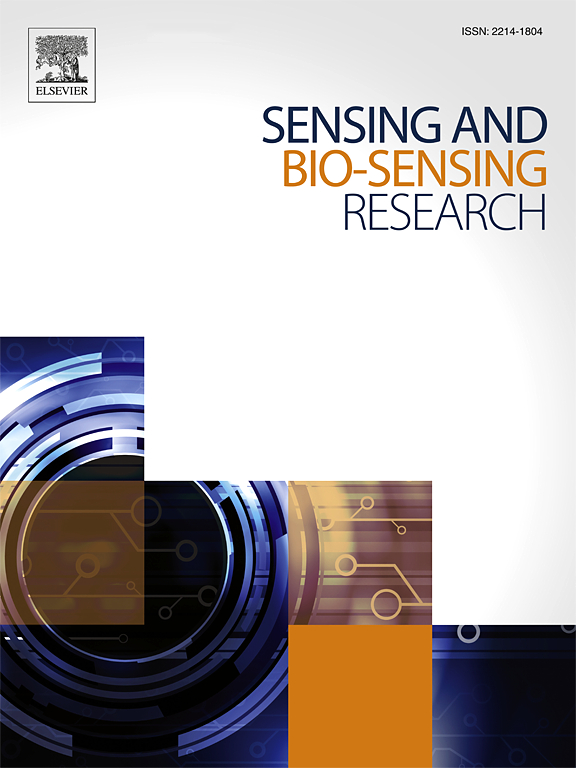用超分子溶剂微萃取氰基二硫腙加合物检测微量氰化物的超灵敏微型光学传感器
IF 4.9
Q1 CHEMISTRY, ANALYTICAL
引用次数: 0
摘要
由于氰化物对生态系统和公众健康的致命性,对水环境中亚痕量氰化物离子(CN -)的超灵敏检测已成为一项势在必行的分析挑战。基于显色加合物形成的波长依赖光谱化学方法在水介质中用于CN -定量的实现仍然具有本质上的挑战性,因为固有的自吸性、光谱卷积和漫反射背景散射共同影响了分析分辨率和选择性。在本研究中,基于超分子溶剂分散液-液微萃取(SM-DLLME)策略,在小型化紫外可见分光光度法定量之前,设计了一种新颖的、生态兼容的、分析稳健的样品预处理方案,用于从水基质中提取超痕量CN -离子。超分子相是由分散在四氢呋喃(THF)中的1-辛醇自组装的反胶束组成的,当将二元溶剂混合物注入pH为10的含CN−的水溶液中时,超分子相自发产生。随后的超声波照射促进了快速胶束化和分散,使疏水中性棕橙色氰二硫腙加合物[CN(H₂Dz) 2]得到有效分配,离心后提取到超分子相。该显色加合物在λmax = 470 nm处对CN -离子进行定量测定,在0.05 ~ 0.3 μg/mL浓度范围内呈线性关系(R2 = 0.999)。检测限和定量限分别为1.03 × 10−2和4.01 × 10−2 μg/mL。该传感器应用于加标的真实水样中,回收率为100.3±2.4 %至101.8±1.7 %,并通过学生t检验(text = 1.5 <;tab = 2.78, n = 5, P = 0.05)。此外,系统地阐明了[CN(H₂Dz) 2]加合物形成的化学平衡、化学计量结构和热力学参数。该方法可作为食品、生物胺和食品新鲜度检测的优良替代方法。双硫腙作为功能络合剂的加入,显著提高了所建立的SM-DLLME体系的传感性能和选择性,从而扩大了复杂水溶液中CN -离子超痕量检测的分析范围。该制备方法避免了有毒有机溶剂或复杂纳米材料的使用,为环境水中CN -离子的监测和质量控制提供了一种直接有效的策略。本文章由计算机程序翻译,如有差异,请以英文原文为准。

Ultrasensitive miniaturized optical sensor for trace cyanide detection via supramolecular solvent microextraction of cyano-dithizone adduct
The ultrasensitive detection of cyanide ions (CN−) at sub-trace levels in aqueous environments has emerged as an imperative analytical challenge, driven by its lethality for ecological systems and public health. The implementation of wavelength-dependent spectrochemical methodologies based on chromogenic adduct formation for CN− quantification in aqueous media remains intrinsically challenging, owing to intrinsic self-absorbance, spectral convolution, and diffuse background scattering that collectively compromise analytical resolution and selectivity. In this study, a novel, eco-compatible, and analytically robust sample pretreatment protocol was devised for the ultra-trace extraction of CN− ions from aqueous matrices, based on supramolecular solvent-based dispersive liquid–liquid microextraction (SM-DLLME) strategy, prior to miniaturized UV–visible spectrophotometric quantification. The supramolecular phase, comprising self-assembled reverse micelles of 1-octanol dispersed in tetrahydrofuran (THF), was spontaneously generated upon injection of the binary solvent mixture into CN−-containing aqueous solutions buffered at pH 10. Subsequent ultrasonic irradiation facilitated rapid micellization and dispersion, enabling the efficient partitioning of the hydrophobic neutral brownish-orange cyano-dithizone adduct [CN(H₂Dz)₂], centrifuged and extracted into the supramolecular phase. The chromogenic adduct was quantitatively assessed for CN− ions at λmax = 470 nm, with linearity across the concentration range 0.05–0.3 μg/mL (R2 = 0.999). The acquired detection and quantification limits were 1.03 × 10−2 and 4.01 × 10−2 μg/mL, respectively. The sensor was implemented in spiked real water samples and yielded outstanding recoveries (100.3 ± 2.4 % to 101.8 ± 1.7 %), validated via the Student's t-test (texp = 1.5 < ttab = 2.78, n = 5, P = 0.05). Furthermore, the chemical equilibrium, stoichiometric configuration, and thermodynamic parameters governing formation of the [CN(H₂Dz)₂] adduct were systematically elucidated and assigned. The assay can assist as a talented substitute for CN− detection in food, biogenic amines and food freshness. Incorporation of dithizone as a functional complexing agent markedly enhanced the sensing performance and selectivity of the established SM-DLLME system and thus enhanced the analytical scope for ultra-trace detection of CN− ions in complex aqueous matrices. The proposed sample prep avoids the use of toxic organic solvents or complex nanomaterials, providing a direct and effective strategy for monitoring and quality control of CN− ions in environmental water.
求助全文
通过发布文献求助,成功后即可免费获取论文全文。
去求助
来源期刊

Sensing and Bio-Sensing Research
Engineering-Electrical and Electronic Engineering
CiteScore
10.70
自引率
3.80%
发文量
68
审稿时长
87 days
期刊介绍:
Sensing and Bio-Sensing Research is an open access journal dedicated to the research, design, development, and application of bio-sensing and sensing technologies. The editors will accept research papers, reviews, field trials, and validation studies that are of significant relevance. These submissions should describe new concepts, enhance understanding of the field, or offer insights into the practical application, manufacturing, and commercialization of bio-sensing and sensing technologies.
The journal covers a wide range of topics, including sensing principles and mechanisms, new materials development for transducers and recognition components, fabrication technology, and various types of sensors such as optical, electrochemical, mass-sensitive, gas, biosensors, and more. It also includes environmental, process control, and biomedical applications, signal processing, chemometrics, optoelectronic, mechanical, thermal, and magnetic sensors, as well as interface electronics. Additionally, it covers sensor systems and applications, µTAS (Micro Total Analysis Systems), development of solid-state devices for transducing physical signals, and analytical devices incorporating biological materials.
 求助内容:
求助内容: 应助结果提醒方式:
应助结果提醒方式:


